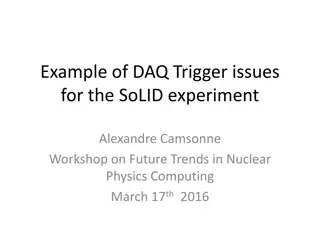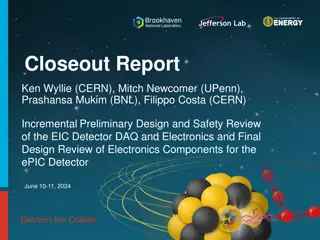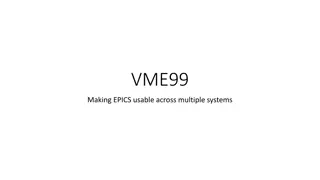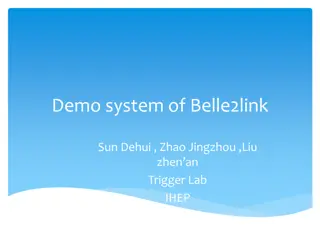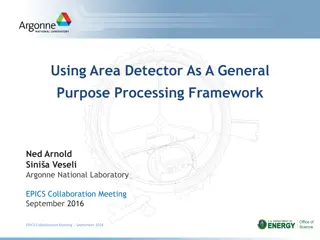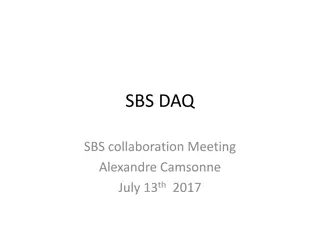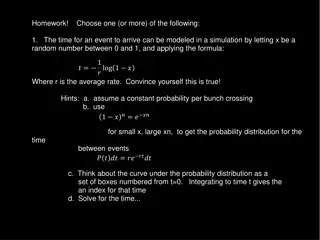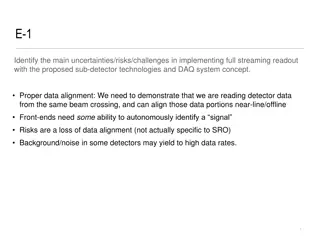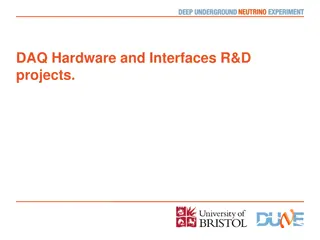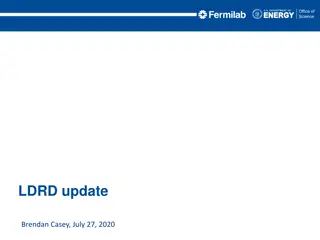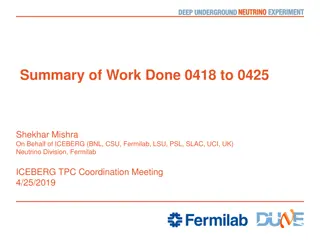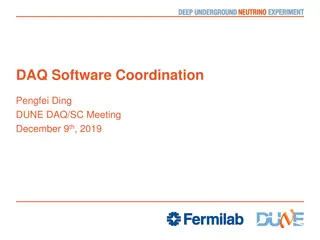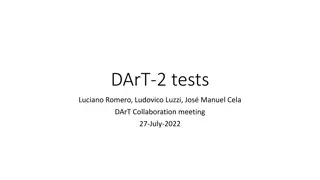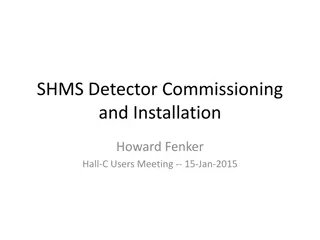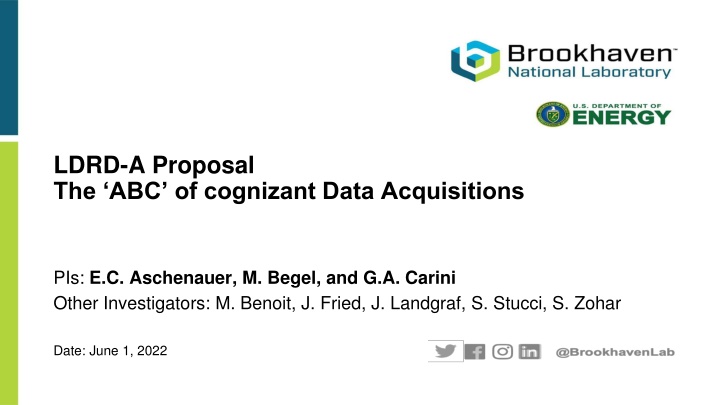
Innovative Cognizant Data Acquisitions Project
Explore a cutting-edge project aiming to revolutionize data acquisitions in collider and accelerator facilities by implementing AI/ML technologies into detector readout electronics. Enhance data quality, reduce storage needs, and expedite data processing to publication. Discover the potential of modular building blocks for a cognizant DAQ system applicable across various experiments.
Download Presentation

Please find below an Image/Link to download the presentation.
The content on the website is provided AS IS for your information and personal use only. It may not be sold, licensed, or shared on other websites without obtaining consent from the author. If you encounter any issues during the download, it is possible that the publisher has removed the file from their server.
You are allowed to download the files provided on this website for personal or commercial use, subject to the condition that they are used lawfully. All files are the property of their respective owners.
The content on the website is provided AS IS for your information and personal use only. It may not be sold, licensed, or shared on other websites without obtaining consent from the author.
E N D
Presentation Transcript
LDRD-A Proposal The ABC of cognizant Data Acquisitions PIs: E.C. Aschenauer, M. Begel, and G.A. Carini Other Investigators: M. Benoit, J. Fried, J. Landgraf, S. Stucci, S. Zohar Date: June 1, 2022
FY2023 NPP LDRD Type A Proposal Proposal Title (proposal Type A): The 'ABC' of cognizant DAQs Principal Investigator: E.C. Aschenauer, M. Begel and G. Carini Department/Division: NPP/P0 and ATRO/IO Other Investigators: M. Benoit, J. Fried, J. Landgraf, S. Stucci, S. Zohar Indicate if this is a cross -directorate proposal. If yes, Identify submitting directorate; i.e., NPP ATRO - CSI (?) Yes _X__ No___ Proposal Term: From - 10/01/2022 To 09/30/2025 2
Heart of the Proposal DAQ systems are the heart of any detector at a collider or accelerator facility. Having the possibility to enhance recorded signal purity and quality by filtering out noise and/or correcting quickly sub-detector performance issues would have several long-lasting advantages. improve effective use of the delivered luminosity reduce requisite storage space from exabyte scale by several orders of magnitude offline data calibration and reconstruction and such time to publication would be reduced. This significantly enhanced data quality can be achieved if one designs a cognizant DAQ, which brings intelligence based on AI/ML from offline post processing into the detector readout electronics. This will allow for use of Deep Neural Networks (DNN) with low power consumption and latency to classify and discriminate between real signal-based hits/events from false positives. Additionally, this will enhance the quality of the signal events by detecting problems in sub-detector performances by interfering and recalibrating the problematic section of the detector. The goal of this R&D project is to provide a set of modular building blocks (software and hardware) for a cognizant DAQ easily applicable at different experiments. 3
Description of the LDRD Proposal The goal of this R&D project is to provide a set of modular building blocks (software and hardware) for a cognizant DAQ easily applicable at different experiments. prototype electronic boards to integrate intelligence next to the Detector and develop an autonomous system software and algorithms to integrate the intelligence next to the detector full readout chain of detector based on a SiPM photosensor based calorimeter system this will allow us to use already existing electronics boards and update them to integrate AI/ML Full chains: detector readout detector detector readout analysis readout detector AI/ML Tools run on FELIX FPGA and on CPU/GPU FPGA provides low-latency active control of detector and self-calibration capability CPU/GPU provides fast analysis and response to quickly-changing conditions Examples: readout mode changed based on local conditions (e.g., between zero-suppressed and full-channel): rare conditions (e.g., supernova @ DUNE, synchrotron event in Si MAPS) unexpected signals (e.g., noise bursts) anticipated special events (e.g., radiation damage from beam interaction) analysis of event requires stronger response: self-calibration for quickly-changing local conditions (e.g., radiation and temperature in SiPM) adjust operational mode for readout (e.g., noise suppression) re-optimize readout in streamed DAQ (e.g., load balance) 4
Proposed Budget/Accomplishments in Year 1 - 3 Expected Results: Software and algorithms to integrate intelligence next to detector Prototype electronic boards to integrate intelligence next to detector and develop an autonomous calibration system (based on existing FELIX card) Milestones: Year 1 o Use simulated data to select and tune AI/ML algorithm and test application on data o Demonstrate real-time detector configuration change in response to conditions through AI/ML o Proof of concept based on existing calorimeter system based on a silicon photomultiplier photosensor readout & FELIX (currently in operation at STAR@RHIC) Year 2 o Demonstrate real-time data calibration in response to detector conditions through ML/AI tools. Year 3 o Full chain of ML/AI tools in firmware & software to optimize data taking in response to detector conditions through ML/AI tools. All personnel with relevant experience and equipment already at BNL fast start! $500k/year budget 5
LDRD Overview/Alignment to the Labs Strategy BNL s developing strategy on AI/ML has several thrusts including AI enhanced detectors, accelerators and sensors. The laboratory user facilities will produce increasingly large amount of data. The proposed research will serve as concrete demonstration of how extensively real-time AI/ML can be used to optimize detector data (management and handling) close to the generation point It will provide a different approach to improve data quality, and in turn detector performance, aiming to produce the optimal value of information per available electrical power (a typical figure of merit) It will reduce the need for human control making the use of complex detection systems (more) autonomous 6
Why Brookhaven At BNL all STARs align... Extensive expertise in operating large collider detectors building specialized instrumentation demonstrated capability in high-throughput custom hardware-based DAQ using high-speed FPGA created FELIX, CaRIBOu, high-speed electronics for ATLAS, DUNE, sPHENIX, BMX hardware-based real-time AI/ML available infrastructure, talent, expertise, and drive to succeed Timely opportunity all components at BNL right now opportunity to create new experimental techniques synergistic development across multiple areas of the lab: NP, HEP, IO strategic growth Widely applicable to many potential needs HEP & NP EIC, DUNE, HL-LHC, Belle II, 21 cm, ... BES Light Sources CSI platform for future algorithm development 7
Potential Financial Return on Investment BNL can capture design of modern DAQ systems for EIC (NP) and DUNE (HEP), which are estimated to be $26M and $8M, respectively improved efficiency at colliders and light sources at these expensive-to-operate facilities decreasing experimental deadtime by 5% at EIC would save $9.4M/year higher quality data per dollar spent Using cognizant DAQs at HEP, NP, and BES experiments leads to reduced computing storage costs improving signal-to-background by 10% saves EIC $300k/year for archiving media new beam lines being planned for NSLS-II can take advantage of these savings Potential patent for suite of modular IP cores that can be deployed in FPGA readout electronics across different facilities. This patent can be marketed and form part of an SPP. 8
Impact having Delayed the Project by a Year Loss of unique opportunity to get ahead of other labs CERN is gearing up on this window to significantly impact the development of the EIC DAQ design is shrinking Loss of momentum Labor resources moved to other projects priorities change one earlier collaborator took a job outside research 9

